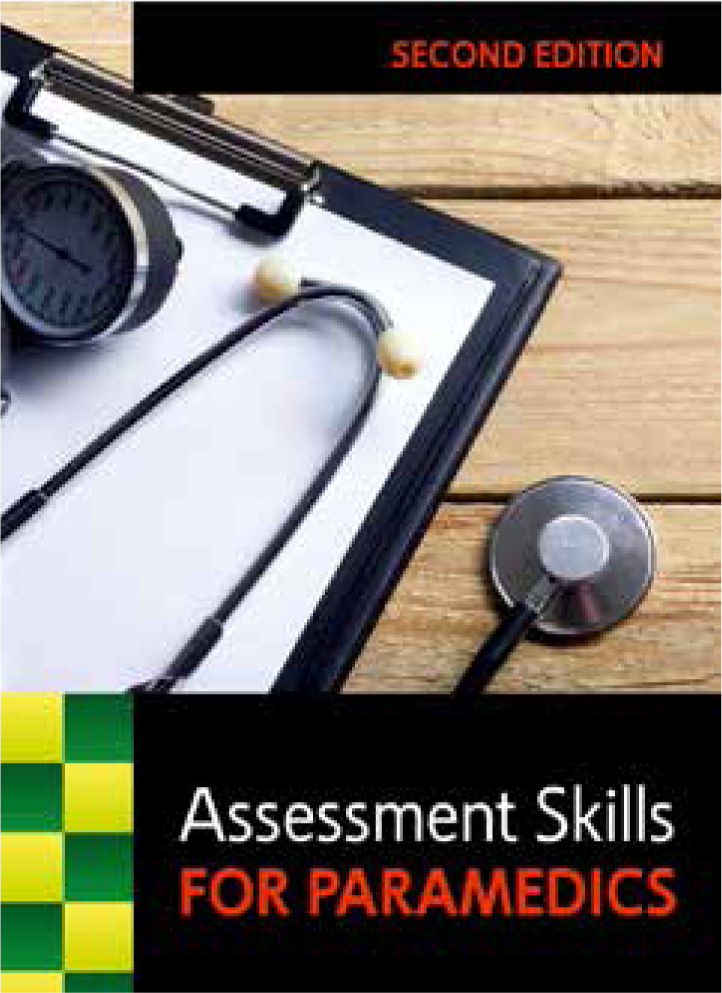
Let's take in the eye-catching cover of Assessment Skills for Paramedics. Immediately the target audience is made clear: paramedics. As is the topic: assessment skills. But the title is just a pretence to lure the reader in; in reality, this book offers much more.
The book's main focus is on the process and skills of assessment, but it also touches on history-taking, patient management and differential diagnosis. Each chapter covers a topic ranging from respiratory and cardiovascular assessments, to more specific subjects such as spinal injuries, and assessment of older patients and minor ailments. Within each chapter is the same structure: scene assessment; primary survey (DR-ABCDE with slight variations for trauma, obstetrics and child assessment); secondary survey; history-taking; system review, vital signs; physical examination; and common conditions. This makes it rather repetitive when read chronologically—yet as an aide-memoire, this clear structure is undoubtedly helpful. The book's primary audiences are undergraduate students and registered paramedics wishing to update their skills. The editors also suggest it may be used for exam revision or looking up specific assessments en route to an incident.
Editors Amanda Blaber and Graham Harris are well-known within paramedic literature, and have experience in education. This provides confidence in this book's relevance to paramedics in training. The chapter authors are a mixture of paramedics, nurses and medical doctors. It is inspirational to see that paramedics were actively involved in writing the majority of this book. However, this observation by no means minimises the value of learning from experienced non-paramedic clinicians who authored chapters on children, obstetric patients and newborns.
Compared to other assessment books, I found this one easier to read, more portable, and better value for money. There are helpful illustrations and an abundance of references such as the National Institute for Health and Care Excellence (NICE), Resuscitation Council UK, the Joint Royal Colleges Ambulance Liaison Committee (JRCALC) and the UK Sepsis Trust. This 2nd edition also proves it is moving with the times by including sepsis—a hot topic in pre-hospital care.
The book's main appeal is its pre-hospital setting compared with alternative textbooks in controlled primary care environments. This is especially noticeable in the scene assessment and danger sections, but also in the discussions surrounding the destination, specialist referral, and non-conveyance of patients. It is also apparent when the text discusses vital signs, diagnostic tests, and drugs that are within the remit of UK paramedics. Red flag symbols to indicate areas that may require immediate attention are another useful feature (e.g. critical skin in a musculoskeletal injury or vaginal bleeding in an obstetric patient). At the end of the book, the reader finds another helpful addition: a glossary.
Regarding limitations, there are two that come to mind: graphics and size. The graphics are not in colour and are few and far between; therefore readers may be missing out on visual aid from photographs, such as rashes, battle signs and bulging fontanelles. Additionally, the book is described as ‘pocket’ size which is unlikely given that its dimensions measure slightly larger than A5. However, both of these limitations are miniscule compared to the book's strengths and are probably unavoidable—but maybe the ‘pocket’ book claim needs re-evaluation.
In conclusion, Assessment Skills for Paramedics is certainly a valuable referencing tool for students and those returning to practice. Nevertheless, experienced paramedics should not dismiss it as being too basic. Rather, they should see this as an opportunity to refresh their patient assessment skills and become incredibly good at the basics—a necessary foundation for any advanced paramedic skills.

